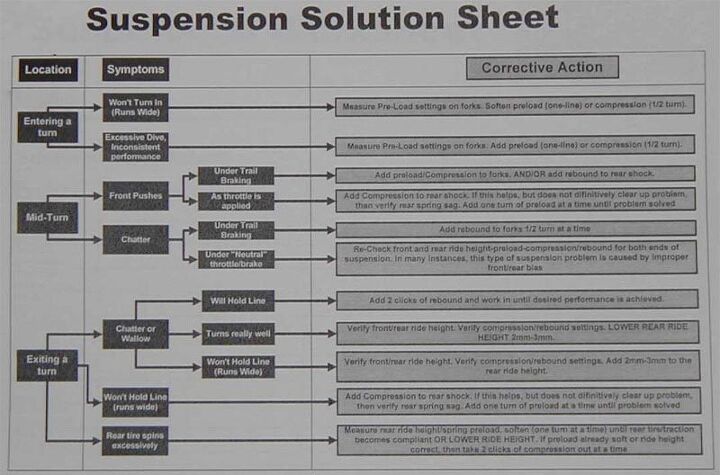Community Tip: Suspension Help – Learn the Lingo
Do you have a lot of Free Sag?
hoser down at the Kawiforums was generous enough to post a glossary and troubleshooting guide to help everyone understand the suspension lingo, jargon that is out there along with solutions to suspension causing problems.
Every activity has its own language. Learning a new skill sometimes feels as if it requires scaling a linguistic learning curve that makes surmounting Mt. Everest seem like a day hike. To the uninitiated–not that any Sport Rider reader could be accused of this–the language of motorcyclists can seem just as daunting. So, to make sure we’re all standing on top of the same hill, peruse the terminology below to help speed yourself along to suspension enlightenment.
Here are a few terms from the glossary:
Bottoming (also called bottoming out)–when a suspension component reaches the end of its travel under compression. Bottoming is the opposite of topping out. Cartridge Fork–a sophisticated type of fork that forces oil through bending shims mounted to the face of damping pistons contained within the fork body. The primary advantage of cartridge forks is they are less progressive than damping rod forks. The shims allow damping control at very low suspension speeds while high speeds deflect the shims more–causing less high-speed damping than fixed orifice damping rods. The resulting ride is firmer with less dive under braking while simultaneously lessening the amount of force square-edged bumps transfer to the chassis.
Free Sag–the amount the bike settles under its own weight. Both streetbikes and race bikes require 0 to 5mm of free sag on the rear. The bike should not top out hard.
High-Speed Damping–damping to control fast vertical movements of suspension components caused by road characteristics such as square-edged bumps. High-Speed damping is independent of motorcycle speed.
Hit the jump to see some troubleshooting write-ups that hoser has done that involve the suspension of your bike. hoser seems like quite the intelligent guy and his write-ups are well done. Head over to his thread to see all of them and don’t forget to thank him for all his efforts!
UNDERSTEERING ERNIE
Problem:
Ernie is having a lot of trouble with his bike’s front end, especially while exiting turns. His front tire loses traction and pushes to the point where it’s washed out on him a couple of times. He notes that steering is a bit heavy, and on uneven sections of pavement the front tire skips over bumps and threatens to fold if pushed too hard.
Solution:
The trouble Ernie is experiencing is probably due to a combination of sag and ride height settings that leaves his bike riding high up front. Having a front tire skip over bumps on the exit of a turn is a sign that the fork is topping out–without enough sack to allow the suspension to sink into depressions in the road.
Ernie should check his bike’s front and rear sag settings to ensure correct spring preload. With the preload set, he should take his bike for a spin to determine if there’s any change in its behavior. If the problems persist, backing off the front preload will drop the front of the bike a bit, quickening the steering and letting the wheel track over bumps more effectively. If, however, the fork starts to bottom under braking with the preload backed off, the fork tubes can be raised in the triple clamps to sharpen the steering while keeping the original preload setting.
REAR-SWAPPING RICHARD
Problem:
When Richard gets on the brakes aggressively while approaching a corner, the bike’s rear end begins to swap side-to-side, and feels as if it wants to pivot around the front.
Solution:
The cause here is way too much front end weight transfer under braking. The front end is compressing so low that the bike’s weight tries to pivot around the steering head, causing the side-to-side movement. The quickest solutions here are to increase the front fork spring preload and/or raise the front ride height by dropping the fork tubes in the triple clamps, or decrease the rear ride height by shortening the shock (if possible). Richard should try increasing the fork spring preload first, and progressing in small increments until the handling begins to be negatively affected (remember to watch the rebound damping when increasing the spring preload). If that doesn’t work, Richard should try the ride height modifications; watch for adverse handling reactions in other areas when doing this as ride height changes drastically affect how the bike corners. Other solutions to try–although less effective–are to increase the compression damping in the forks (if possible), or to decrease rebound damping in the rear (to allow the rear tire to follow the pavement quicker). Again, Richard should watch for adverse handling reactions in other riding situations when test riding.
The thread has a TON of scenarios to read through so check it out to better understand your ride.
More by Mark Prociw





























Comments
Join the conversation